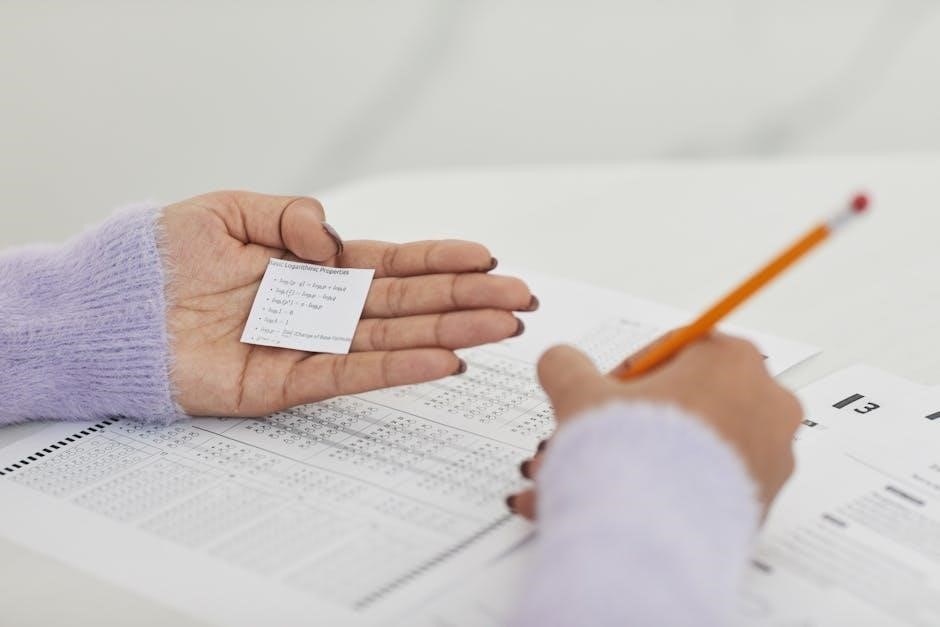dalton’s law of partial pressure worksheet with answers pdf
Daltons Law of Partial Pressure is a fundamental concept in chemistry, describing the relationship between the partial pressures of gases in a mixture, with
theoretical
explanations and examples provided online.
Definition and Importance
Daltons Law of Partial Pressure is defined as the sum of the individual pressures of all the gases that make up a mixture, which is equal to the total pressure. This concept is crucial in understanding the behavior of gases in various chemical reactions and industrial processes. The importance of Daltons Law lies in its ability to predict the partial pressure of each gas in a mixture, allowing chemists to calculate the total pressure and make informed decisions. With the help of online resources, such as worksheets and practice problems, students can gain a deeper understanding of this fundamental concept. By mastering Daltons Law, individuals can apply it to real-world scenarios, including the calculation of partial pressures in industrial processes and the analysis of gas mixtures. This knowledge is essential for chemists, engineers, and researchers working in various fields, including chemistry, physics, and materials science.
Application in Chemistry
Daltons Law of Partial Pressure has numerous applications in chemistry, including the calculation of partial pressures in gas mixtures, analysis of respiratory gases, and determination of the composition of gas mixtures. In the field of chemistry, this law is used to predict the behavior of gases in various reactions, such as combustion and oxidation reactions. The law is also applied in the production of industrial gases, such as oxygen and nitrogen, and in the analysis of atmospheric gases. Furthermore, Daltons Law is used in the study of chemical equilibria, where it helps to predict the partial pressures of reactants and products. By applying this law, chemists can gain a deeper understanding of the behavior of gases and develop new technologies and processes. Online resources, such as worksheets and practice problems, provide students with the opportunity to apply Daltons Law to real-world scenarios and develop their problem-solving skills.

Daltons Law of Partial Pressure Worksheet
Online worksheets provide practice problems and solutions for Daltons Law, with answers in PDF format available for download and reference purposes online easily.
Questions and Answers
Questions and answers on Daltons Law of Partial Pressure are available online, providing students with a comprehensive resource to test their understanding of the concept. The questions cover various aspects of the law, including the calculation of partial pressures, the relationship between partial pressures and mole fractions, and the application of the law to real-world scenarios. The answers are provided in detail, with step-by-step explanations and examples to help students understand the concepts. The questions and answers are also available in PDF format, making it easy for students to download and print them for reference purposes. Additionally, online resources provide practice questions, MCQs, and PYQs to help students prepare for exams and assessments. The questions and answers are designed to help students develop a deep understanding of Daltons Law of Partial Pressure and its applications in chemistry. Online resources also provide solutions and explanations to help students understand the concepts.
Practice Problems and Solutions
Practice problems and solutions on Daltons Law of Partial Pressure are essential for students to master the concept. Online resources provide a range of practice problems, including numerical problems, theoretical questions, and mixed-question types. The problems are designed to test students’ understanding of the law and its applications, and to help them develop problem-solving skills. Solutions to the problems are also provided, with step-by-step explanations and calculations to help students understand the concepts. The practice problems and solutions are available in PDF format, making it easy for students to access and use them. By working through the practice problems and solutions, students can develop a deep understanding of Daltons Law of Partial Pressure and its applications in chemistry, and can improve their performance in exams and assessments. Online resources also provide additional support and guidance to help students with difficult problems.

Partial Pressure Questions and Answers
Online resources provide partial pressure questions and answers in PDF format for easy access and practice.
MCQs, PYQs, NCERT Questions, and Question Bank
Multiple choice questions, previous year questions, and NCERT questions are available online to help students practice and assess their understanding of partial pressure concepts.
The question bank includes a wide range of questions, from basic to advanced levels, covering various aspects of partial pressure and Daltons Law.
Online resources provide access to these questions, along with answers and solutions, to facilitate learning and revision.
Students can use these resources to identify areas where they need improvement and focus their studies accordingly.
The question bank is regularly updated to reflect changes in the curriculum and exam patterns, ensuring that students have access to the most relevant and useful study materials.
By practicing with these questions, students can develop a deeper understanding of partial pressure and improve their performance in exams.
The online resources also provide tips and strategies for solving problems and answering questions, helping students to build confidence and achieve their academic goals.
Class 11 and Class 12 Questions, NCERT Exemplar Questions
For students in Class 11 and Class 12, NCERT exemplar questions are available to help them prepare for exams and assessments.
These questions cover various topics related to partial pressure and Daltons Law, including the behavior of gases and the calculation of partial pressures.
The NCERT exemplar questions are designed to test students’ understanding of the concepts and their ability to apply them to solve problems.
Online resources provide access to these questions, along with answers and solutions, to help students learn and revise.
The questions are categorized by topic and difficulty level, making it easier for students to focus their studies and identify areas where they need improvement.
For example, questions on the calculation of partial pressure, the behavior of gases in a mixture, and the application of Daltons Law are included.
By practicing with these questions, students can develop a deeper understanding of the concepts and improve their performance in exams.
The online resources also provide study materials and tips to help students prepare for their exams.

Daltons Law of Partial Pressures Worksheet 1
Calculating pressure of a mixture of gases using
mathematical
formulas and equations.
Calculating Pressure of a Mixture of Gases
To calculate the pressure of a mixture of gases, we use the formula P_total = P1 + P2 + … + Pn, where P_total is the total pressure of the mixture and P1, P2, etc. are the partial pressures of each gas. This formula is based on Dalton’s Law of Partial Pressures, which states that the total pressure of a mixture of gases is equal to the sum of the partial pressures of each gas. We can calculate the partial pressure of each gas using the formula P_i = (n_i / n_total) * P_total, where n_i is the number of moles of gas i and n_total is the total number of moles of all gases. By plugging in the values, we can calculate the pressure of the mixture of gases. This concept is crucial in chemistry and is used to solve various problems. The formula is widely used in chemistry and is an essential part of the curriculum.
Connected Flasks and Partial Pressures
When two flasks are connected with a stopcock, the gases in each flask can mix and reach equilibrium. The partial pressure of each gas in the connected flasks can be calculated using Dalton’s Law of Partial Pressures. The formula for calculating the partial pressure of a gas in a connected flask is P_i = (n_i / n_total) * P_total, where n_i is the number of moles of gas i and n_total is the total number of moles of all gases. The volume of each flask and the number of moles of each gas are important factors in determining the partial pressure. By applying Dalton’s Law, we can calculate the partial pressure of each gas in the connected flasks and determine the total pressure of the mixture. This concept is essential in understanding the behavior of gases in mixed systems. The calculation of partial pressures in connected flasks is a common problem in chemistry worksheets and exams.

Worksheet C53: Daltons Law of Partial Pressures
Daltons Law applies to gas mixtures, with online resources providing worksheets and answers in PDF format for easy access and learning.
Mole Fraction and Partial Pressure
The relationship between mole fraction and partial pressure is a crucial aspect of Daltons Law, with online resources providing detailed explanations and examples to illustrate this concept.
The mole fraction of a gas is defined as the number of moles of that gas divided by the total number of moles of all gases in the mixture.
This value can then be used to calculate the partial pressure of the gas, which is equal to the mole fraction multiplied by the total pressure of the mixture.
Online worksheets and practice problems are available to help students master this concept and apply it to real-world scenarios.
By understanding the relationship between mole fraction and partial pressure, students can better comprehend the behavior of gases in mixtures and make accurate calculations.
This knowledge is essential for solving problems in chemistry and physics, and is a fundamental aspect of Daltons Law of Partial Pressures.
The internet provides numerous resources, including worksheets and answers in PDF format, to support learning and practice.

